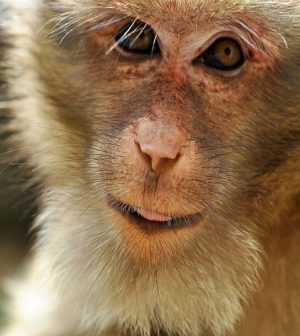- Skip Storing This Everyday Product in the Fridge Door
- Green Tea + B3 Pairing May Boost Brain Health
- Navigating Your Midlife Crisis: Embracing New Possibilities
- City Raccoons Showing Signs of Domestication
- Mapping the Exposome: Science Broadens Focus to Environmental Disease Triggers
- One Week Less on Social Media Linked to Better Mental Health
- Your Brain Changes in Stages as You Age, Study Finds
- Some Suicide Victims Show No Typical Warning Signs, Study Finds
- ByHeart Formula Faces Lawsuits After Babies Sickened With Botulism
- Switch to Vegan Diet Could Cut Your Greenhouse Gas Emissions in Half
Dangerous Virus Found in Monkeys Could Jump to Humans

The global public health community should be on the alert for a family of viruses in African monkeys that have the potential to spill over to humans, researchers warn.
In their new study, the scientists noted that while it’s not certain what impact these viruses might have on humans, there are troubling parallels to HIV.
“This animal virus has figured out how to gain access to human cells, multiply itself and escape some of the important immune mechanisms we would expect to protect us from an animal virus. That’s pretty rare,” said senior author Sara Sawyer, a professor of molecular, cellular and developmental biology at the University of Colorado Boulder.
“We should be paying attention to it,” she said in a university news release.
Known as arteriviruses, this family of viruses are a critical threat to macaque monkeys. They can cause fatal Ebola-like symptoms in some monkeys. No human infections have been reported, but remaining vigilant could help avoid a future pandemic, the authors noted.
Sawyer’s lab used tissue samples from wildlife to help identify which animal viruses among the many circulating might jump to humans.
Although arteriviruses are common in pigs and horses, they aren’t well studied in non-human primates, according to researchers. Specifically, the team looked to the simian hemorrhagic fever virus (SHFV), which has caused deadly outbreaks in captive macaque colonies.
A receptor called CD163 plays a key role in the biology of simian arteriviruses, according to the study, which was published Sept. 30 in the journal Cell. It enables the virus to invade and infect target cells.
Researchers did experiments in the lab, leading to the discovery that the virus was adept at latching on to the human version of CD163, getting inside human cells and replicating.
Similar to HIV and its precursor simian immunodeficiency virus (SIV), simian arteriviruses attack immune cells. This disables key defense mechanisms and allows it to take hold in the body long-term.
“The similarities are profound between this virus and the simian viruses that gave rise to the HIV pandemic,” said Cody Warren, previously a postdoctoral fellow at CU Boulder and now an assistant professor in the College of Veterinary Medicine at Ohio State University.
SIVs in non-human primates in Africa likely began jumping to humans in the early 1900s, decades before the HIV epidemic began, without awareness by those in health care, the authors said.
“Just because we haven’t diagnosed a human arterivirus infection yet doesn’t mean that no human has been exposed. We haven’t been looking,” Warren warned in the release.
That doesn’t mean this is about to become an imminent pandemic with arteriviruses, the authors cautioned.
“COVID is just the latest in a long string of spillover events from animals to humans, some of which have erupted into global catastrophes,” Sawyer said. “Our hope is that by raising awareness of the viruses that we should be looking out for, we can get ahead of this so that if human infections begin to occur, we’re on it quickly.”
The authors suggested that the global public health community should prioritize studying these viruses, develop blood antibody tests and consider surveillance of human populations with close contact to animal carriers.
More information
The U.S. Centers for Disease Control and Prevention has information on zoonotic diseases.
SOURCE: University of Colorado Boulder, news release, Sept. 30, 2022
Source: HealthDay
Copyright © 2025 HealthDay. All rights reserved.










